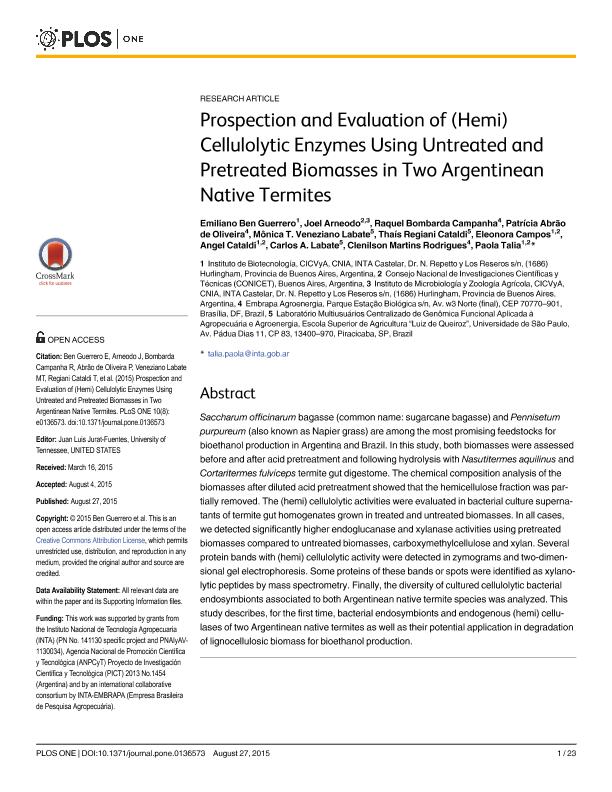Mostrar el registro sencillo del ítem
dc.contributor.author
Ben Guerrero, Emiliano

dc.contributor.author
Arneodo Larochette, Joel Demián

dc.contributor.author
Bombarda Campanha, Raquel
dc.contributor.author
Oliveira, Patrícia Abrão de
dc.contributor.author
Labate, Mônica T. Veneziano
dc.contributor.author
Cataldi, Thaís Regiani
dc.contributor.author
Campos, Eleonora

dc.contributor.author
Cataldi, Ángel Adrián

dc.contributor.author
Labate, Carlos A.
dc.contributor.author
Rodrigues, Clenilson Martins
dc.contributor.author
Talia, Paola Monica

dc.date.available
2018-04-11T17:29:32Z
dc.date.issued
2015-08
dc.identifier.citation
Ben Guerrero, Emiliano; Arneodo Larochette, Joel Demián; Bombarda Campanha, Raquel; Oliveira, Patrícia Abrão de; Labate, Mônica T. Veneziano; et al.; Prospection and Evaluation of (Hemi) Cellulolytic Enzymes Using Untreated and Pretreated Biomasses in Two Argentinean Native Termites; Public Library of Science; Plos One; 10; 8; 8-2015; 1-23
dc.identifier.issn
1932-6203
dc.identifier.uri
http://hdl.handle.net/11336/41726
dc.description.abstract
Saccharum officinarum bagasse (common name: sugarcane bagasse) and Pennisetum purpureum (also known as Napier grass) are among the most promising feedstocks for bioethanol production in Argentina and Brazil. In this study, both biomasses were assessed before and after acid pretreatment and following hydrolysis with Nasutitermes aquilinus andCortaritermes fulviceps termite gut digestome. The chemical composition analysis of the biomasses after diluted acid pretreatment showed that the hemicellulose fraction was partially removed. The (hemi) cellulolytic activities were evaluated in bacterial culture supernatantsof termite gut homogenates grown in treated and untreated biomasses. In all cases, we detected significantly higher endoglucanase and xylanase activities using pretreated biomasses compared to untreated biomasses, carboxymethylcellulose and xylan. Several protein bands with (hemi) cellulolytic activity were detected in zymograms and two-dimensionalgel electrophoresis. Some proteins of these bands or spots were identified as xylanolytic peptides by mass spectrometry. Finally, the diversity of cultured cellulolytic bacterial endosymbionts associated to both Argentinean native termite species was analyzed. This study describes, for the first time, bacterial endosymbionts and endogenous (hemi) cellulases of two Argentinean native termites as well as their potential application in degradation of lignocellulosic biomass for bioethanol production.
dc.format
application/pdf
dc.language.iso
eng
dc.publisher
Public Library of Science

dc.rights
info:eu-repo/semantics/openAccess
dc.rights.uri
https://creativecommons.org/licenses/by/2.5/ar/
dc.subject
Termites
dc.subject
Cellulolytic Enzymes
dc.subject
Endosymbionts
dc.subject
Biofuel
dc.subject.classification
Biotecnología Industrial

dc.subject.classification
Biotecnología Industrial

dc.subject.classification
INGENIERÍAS Y TECNOLOGÍAS

dc.title
Prospection and Evaluation of (Hemi) Cellulolytic Enzymes Using Untreated and Pretreated Biomasses in Two Argentinean Native Termites
dc.type
info:eu-repo/semantics/article
dc.type
info:ar-repo/semantics/artículo
dc.type
info:eu-repo/semantics/publishedVersion
dc.date.updated
2018-04-11T15:12:17Z
dc.journal.volume
10
dc.journal.number
8
dc.journal.pagination
1-23
dc.journal.pais
Estados Unidos

dc.journal.ciudad
San Francisco
dc.description.fil
Fil: Ben Guerrero, Emiliano. Instituto Nacional de Tecnología Agropecuaria. Centro de Investigación en Ciencias Veterinarias y Agronómicas. Instituto de Biotecnología; Argentina
dc.description.fil
Fil: Arneodo Larochette, Joel Demián. Consejo Nacional de Investigaciones Científicas y Técnicas; Argentina. Instituto Nacional de Tecnología Agropecuaria. Centro de Investigación en Ciencias Veterinarias y Agronómicas. Instituto de Microbiología y Zoología Agrícola; Argentina
dc.description.fil
Fil: Bombarda Campanha, Raquel. Ministerio da Agricultura Pecuaria e Abastecimento de Brasil. Empresa Brasileira de Pesquisa Agropecuaria; Brasil
dc.description.fil
Fil: Oliveira, Patrícia Abrão de. Ministerio da Agricultura Pecuaria e Abastecimento de Brasil. Empresa Brasileira de Pesquisa Agropecuaria; Brasil
dc.description.fil
Fil: Labate, Mônica T. Veneziano. Universidade de Sao Paulo; Brasil
dc.description.fil
Fil: Cataldi, Thaís Regiani. Universidade de Sao Paulo; Brasil
dc.description.fil
Fil: Campos, Eleonora. Instituto Nacional de Tecnología Agropecuaria. Centro de Investigación en Ciencias Veterinarias y Agronómicas. Instituto de Biotecnología; Argentina. Consejo Nacional de Investigaciones Científicas y Técnicas; Argentina
dc.description.fil
Fil: Cataldi, Ángel Adrián. Instituto Nacional de Tecnología Agropecuaria. Centro de Investigación en Ciencias Veterinarias y Agronómicas. Instituto de Biotecnología; Argentina. Consejo Nacional de Investigaciones Científicas y Técnicas; Argentina
dc.description.fil
Fil: Labate, Carlos A.. Universidade de Sao Paulo; Brasil
dc.description.fil
Fil: Rodrigues, Clenilson Martins. Ministerio da Agricultura Pecuaria e Abastecimento de Brasil. Empresa Brasileira de Pesquisa Agropecuaria; Brasil
dc.description.fil
Fil: Talia, Paola Monica. Instituto Nacional de Tecnología Agropecuaria. Centro de Investigación en Ciencias Veterinarias y Agronómicas. Instituto de Biotecnología; Argentina. Consejo Nacional de Investigaciones Científicas y Técnicas; Argentina
dc.journal.title
Plos One

dc.relation.alternativeid
info:eu-repo/semantics/altIdentifier/url/http://journals.plos.org/plosone/article?id=10.1371/journal.pone.0136573
dc.relation.alternativeid
info:eu-repo/semantics/altIdentifier/doi/http://dx.doi.org/10.1371/journal.pone.0136573
Archivos asociados
